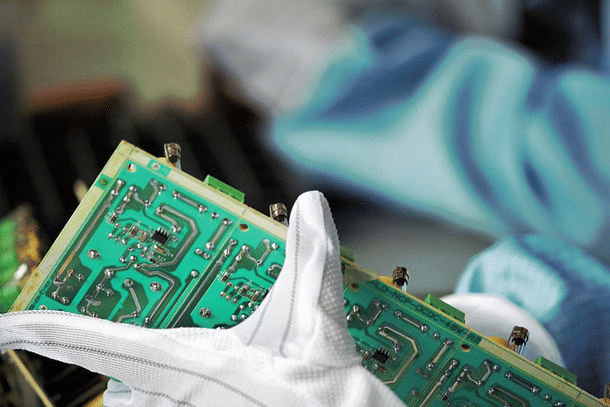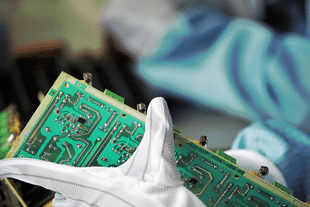Ideas
Chip Cooperation: What A QUAD Collaboration On Semiconductors Would Mean For India
Arun Mampazhy
Feb 10, 2022, 06:04 PM | Updated Feb 12, 2022, 12:05 PM IST
Save & read from anywhere!
Bookmark stories for easy access on any device or the Swarajya app.


Being able to control the current flow for applied voltages form the basis of most electronics.
A diode for example is a two terminal device that conducts current in one direction, ideally with zero resistance and blocks it in the other, ideally with infinite resistance. Early diodes were based on ‘vacuum tubes’, perhaps a more appropriate term would be ‘electron tube’ as they were also sometimes filled with gases at low pressure.
A triode by extension is a three terminal device, originally conceived for the purpose of amplifying analog signals. The 1907 patent by Lee De Forest states: “The objects of my invention are to increase the sensitiveness of oscillation detectors comprising in their construction a gaseous medium by means of the structural features and circuit arrangements...”
Attempts at using semiconductors — most of which are solid — had been happening parallelly. In fact, the first semiconductor diode and quite likely the first semiconductor electronic device — a “crystal detector" was patented in 1901 by Jagadish Chandra Bose. However, it was only until much later in the 1950s or 1960s when transistors using semiconductors started to become commonplace that the term 'solid state electronics' too became popular.
So we are talking about semiconductor or ‘chip’ cooperation here — through the Quadrilateral Security Dialogue (QSD) between Australia, India, Japan and the United States, more commonly known as the QUAD.
Though the history of QUAD may go back a few years, for the purpose of this discussion a starting point will be this fact sheet published on the White House website in March 2021 where "The QUAD Critical and Emerging Technology Working Group" was mentioned. Swarajya had at that time mentioned that "amid a severe shortage of semiconductors in the USA and consequent closure of numerous companies, this decision to form a working group gains significance."
Six months later, the September 2021 fact sheet had a bit more specifics on what it called the "semiconductor supply chain initiative".
"QUAD partners will launch a joint initiative to map capacity, identify vulnerabilities, and bolster supply-chain security for semiconductors and their vital components. This initiative will help ensure QUAD partners support a diverse and competitive market that produces the secure critical technologies essential for digital economies globally."
Multiple media articles followed, especially in India, and interestingly at least one in a mainstream Chinese medium with a title “India courts chip-makers with Taiwan and QUAD on its side, as it takes on China”, note that it was the time when speculations were strong about government in talks with Taiwan for a potential $7.5 billion #FabInIndia.
One of the few studies which offered anything close to some concrete suggestions was this one, wherein the author had said: "Mapping the supply chain vulnerability should only be a first step of the collaboration" and given three main suggestions through which the "grouping can directly bolster supply chain security".
Suggestions included: "forming a consortium aimed at building a diversified semiconductor manufacturing base" of making India as a "Center of Excellence for Semiconductor Design", and "facilitate strategic alliances between companies in each other’s countries". Additionally, India should use the Quad collaboration to get a Japanese or American company to manufacture semiconductors in India, even if it’s at a trailing-edge node such as 65 nm.
Interestingly, most of the countries part of the QUAD have “moved on” — at least seemingly independently — with their policies and efforts ever since. Japan approved $6.8 billion for domestic chip-making industry, about $3.5 billion of which is likely to be used to incentivise the upcoming TSMC-Sony fab.
A few days ago, US House of Representatives “sort of passed its $52 billion CHIPS act” — as per this report. "There now follows a period when the Senate and the House seek to reconcile the differences between their two versions of the bill. The combined version will then have to be voted on again to become law."
On 15 December 2021, India announced a fresh set of policies to boost semiconductor design, assembly as well as various kind of fabs — Silicon CMOS, compound semiconductors, sensor fabs (including MEMS) , Silicon Photonics — and announced an initial overlay of $10 billion — the schemes are open for applications starting 1 January 2022 . A detailed presentation including what kind of incentives are offered under each scheme and what the current deadlines are — can be viewed here.
Some of the suggestions that were mentioned earlier for India, may happen — for example, through the incentives for 100 design companies India wants itself to be seen as a hub in the future. Likewise, there are already globally-reputed fabs like Tower semiconductors (through its India partner Next Orbit Ventures) interested in opening 65 nm Fab with focus on Analog, RF and Power, Tata electronics interested in OSAT and Vedanta looking for partners or technology transfer for 28 nm or below process nodes.
Potential partners for a 28 nm node collaboration include TSMC, Samsung, Intel, UMC and GlobalFoundries. Of these, perhaps only Intel truly belongs to one of the QUAD countries, that is US. GlobalFoundries even though headquartered in US and had a recent IPO, UAE's Mubadala still holds 89.4 per cent shares and voting power.
Here is a brief video where for the first time summary results of a detailed study done by Frost and Sullivan for Next Orbit Ventures on India's chip demand is being made public and also some thoughts on some of the fabs as mentioned above applying for #FabInIndia before the current deadline of 14 February.
The question then becomes what will the semiconductor cooperation through QUAD focus on? India's External Affairs Minister S Jaishankar will participate in the fourth QUAD Foreign Ministers’ meeting in Melbourne on 11 February, however it seems less likely that the efforts will take a solid form as of yet.
Arun Mampazhy has a BTech from IITM and MS from University of Maryland in semiconductor fabrication and over a decade of industry experience. His dreams of seeing a commercial fab takeoff in India has changed from black and white to colour over two decades. He can be reached via email nanoarun(at)gmail(dot)com or @nano_arun on twitter. Views expressed are personal.





